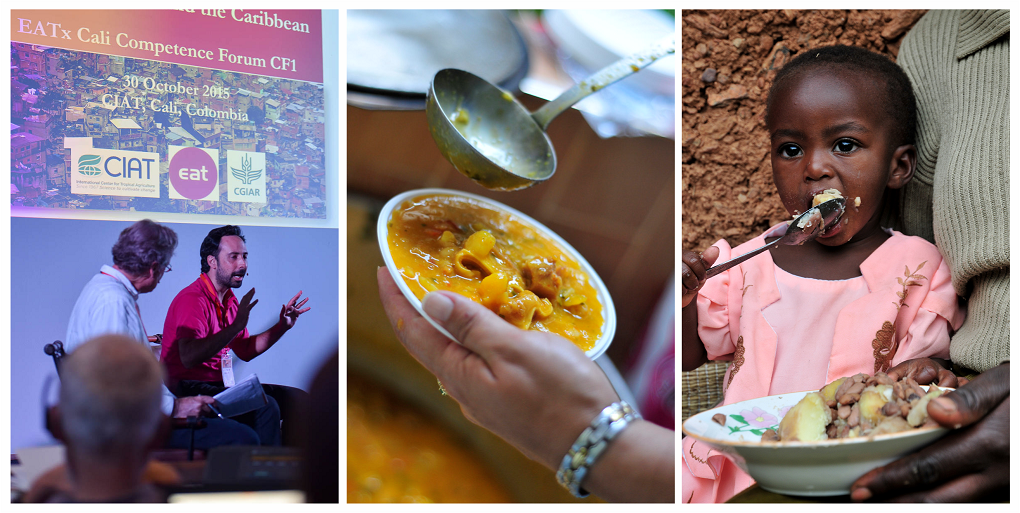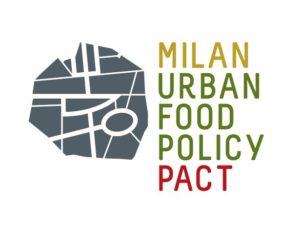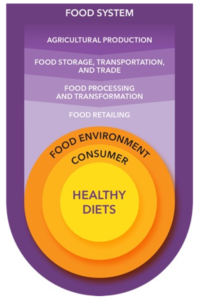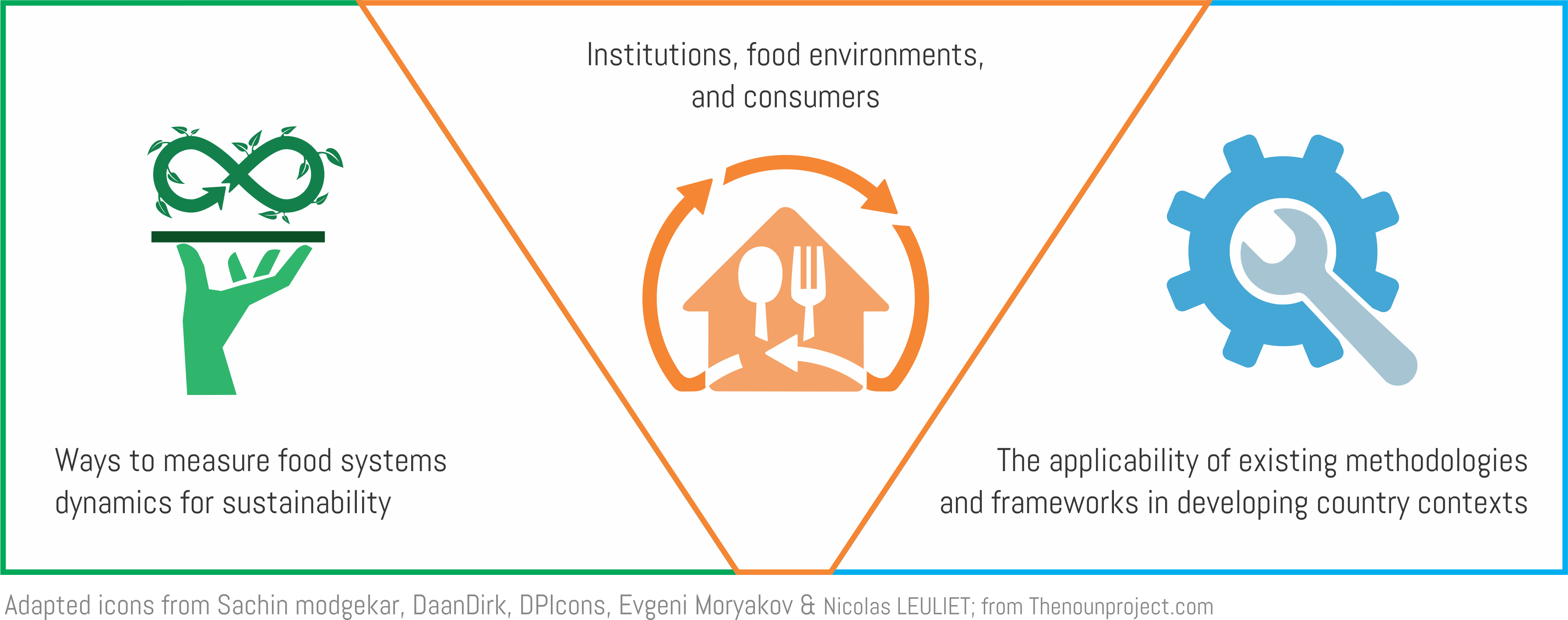Linking local and global food systems for more healthy and sustainable communities

More and more we are hearing that the food system is ‘broken’ – many people aren’t getting enough to eat amidst plenty, more are eating too much when they ‘know’ they shouldn’t, and most aren’t eating the ‘right’ things anyway. Plus, what we are eating, how it is produced, and what is lost or thrown away is contributing to climate change, biodiversity loss, soil degradation, air and water pollution, and a raft of other environmental issues.
Written by: Anna Whitton, Sandra Aronson & Lisa Gerbal
The CIAT Sustainable Food Systems (SFS) research program aims to confront the complex interactions between food systems, human health and equity, and ecological systems by:
- Testing innovations and validating sustainable food system upgrading
- Developing tools and methods for food system analysis
- Producing insights on food systems in key “zoom-in” sites to inform policy.
The team is now beginning to look at three new areas of investigation related to diets, nutrition, and sustainability, starting with short-term projects led by visiting student researchers Sandra Aronson, Lisa Gerbal, and Anna Whitton.

Food systems are complicated, which is why it is important to identify relevant stakeholders and be able to describe their roles and responsibilities. Once stakeholders have been mapped, it becomes easier to see the strengths, gaps, and opportunities within food systems.
My project will focus on food systems in Cali, Colombia, since the city is a “zoom-in” site for the SFS initiative. Over the next few months, I will be interviewing stakeholders including policy makers and members of producer associations, distribution centers, advocacy groups, civil society, and researchers in academia. This will help explain local policy perspectives concerning food security, the state of nutrition, and the city’s approach to the integration of sustainability in its food systems.
 Simultaneously, I will be looking at indicators – that are directly and indirectly related to food systems – from the Plan de Desarrollo del Municipio de Santiago de Cali 2016-2019 [Municipal Development Plan of Santiago de Cali 2016-2019], and will compare or match them to the Monitoring Framework Indicators found in the Milan Urban Food Policy Pact (MUFPP). The Development Plan defines a set of strategies focused on improving and supporting social, cultural, and economic development in Cali, while being environmentally conscious. The MUFPP is an international protocol established in 2015 that calls on mayors of cities worldwide to develop sustainable food practices that ensure safe and adequate nutrition; support equitable food production; and protect the environment. Cali is currently not a signatory city, but if it decided to be, it would be useful to have indicator information on hand.
Simultaneously, I will be looking at indicators – that are directly and indirectly related to food systems – from the Plan de Desarrollo del Municipio de Santiago de Cali 2016-2019 [Municipal Development Plan of Santiago de Cali 2016-2019], and will compare or match them to the Monitoring Framework Indicators found in the Milan Urban Food Policy Pact (MUFPP). The Development Plan defines a set of strategies focused on improving and supporting social, cultural, and economic development in Cali, while being environmentally conscious. The MUFPP is an international protocol established in 2015 that calls on mayors of cities worldwide to develop sustainable food practices that ensure safe and adequate nutrition; support equitable food production; and protect the environment. Cali is currently not a signatory city, but if it decided to be, it would be useful to have indicator information on hand.
Lastly, this project aims to describe which tools can assist decision makers in Cali, as they assess or develop their nutrition agenda. This may improve issues of governance, production, distribution, and disposal within the systems as well as the ongoing monitoring and evaluation needed to measure effectiveness. The great thing is we don’t need to reinvent the wheel. Toolkits that evaluate food system policies and program effectiveness already exist, it’s just a matter of determining what needs to be assessed based on what is already known.
With subnational elections (governors and mayors) coming up, we intend to disseminate the findings among policymakers, partner organizations, and the wider audience in hopes of generating actionable knowledge and spurring future research agendas within CIAT and the community at large.

The impact of cities on the environment through the provisioning of food, water, and energy is becoming increasingly important in both research and public policy. Cities and urban populations are growing, and how to feed them in a more sustainable way has become a complex issue to tackle when analyzing the dynamics of food systems. Diets, or food consumption patterns, are considered “sustainable” if they provide the right amount of nutrients for health, meet people’s needs and preferences and are accessible to all. Moreover, as we become more conscious about the environmental burden of food systems, we look at our plate from a different perspective, and feel compelled to try to assess the environmental cost of what we are eating.

Nieuwsbrief Alles over Voeding 16-10
In this context, my project aims at developing a methodological approach to better assess, understand, and use information on environmental sustainability and resilience of highly consumed products in a community. The proposal is to assess carbon footprint using a Life Cycle Analysis (LCA) methodology and complement it with the Ecocrop methodology that predicts suitability of crops under different climatic conditions by establishing climatic parameters. In this way, we can assess both the impacts of a community’s diet on the environment, as well as the potential impacts of climate change on that diet.
I am focusing on the city of Cali, department of Valle del Cauca, Colombia, as a test case to design the combination of the two methodologies, which will focus on the five most commonly consumed food products (per day) in Cali. It involves drawing upon existing literature and meetings with actors from local supply chains to validate estimates of impacts of the different production processes of the products.
This proposal can be an important tool for decision makers, especially for our case study in Cali, where a fair portion of the products are produced in Valle del Cauca or else in Colombia. What we eat has an impact on climate change, and climate change has an impact on food production as well. We hope that the results of this study will demonstrate to local policy makers the challenges of food systems, what is at stake, and the key areas for intervention. These challenges are local as well as global, and I am pleased to see that CIAT is working in its home community to address them.

My project is looking at, globally, what we think we should be eating and how well this is reflected in the current food supplies of countries across the world. In a food systems framework, the points of interest are at the ‘end’ of the food chain (diets) but also at the ‘beginning’ (what we are growing and trading).

Seeing diet and nutrition outcomes in the food systems context. Source: IFPRI, 2016 adapted from GloPAN, 2016.
If we think about agricultural production as the first point of influence (or intervention) in improving diet quality – for health or for sustainability – we are asking: are we making the right foods, in the right quantities available at this point in the system?
From this point, we hope to be in a better position to look downstream, to what might be getting lost along the way (food and nutrient waste, in processing, retail or in the home) or distributed inequitably; or to what influences what people can and want to eat, is the food safe and nutritious, etc.
In this project, I am using United Nations’ Food and Agriculture Organization (FAO) national food supply and agricultural production datasets to compare country-level diets with ideal diets for health and sustainability. The challenge is finding out what an ‘ideal’ and measurable diet (or diets) might be, so adherence can be assessed and compared across countries.
You can find out more about the project on my research blog and the CIAT Sustainable Food Systems blog.
In (sustainable) food systems, it’s all connected
So, how do each of these different projects fit together? We have two projects centered on Cali – one on its institutions and governance relating to food systems, and another on what people are actually eating here and ways to measure the sustainability impacts for and from this diet – and the third is macro-level, measuring the relative ‘performance’ of diets across the world.
The way we see it, while we are working at different levels, we are all looking at:

We look forward to sharing what we learn as we progress with the projects!
